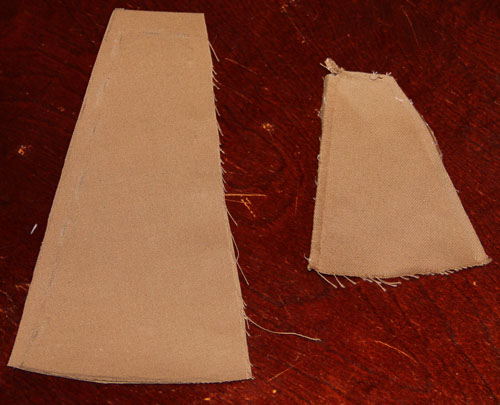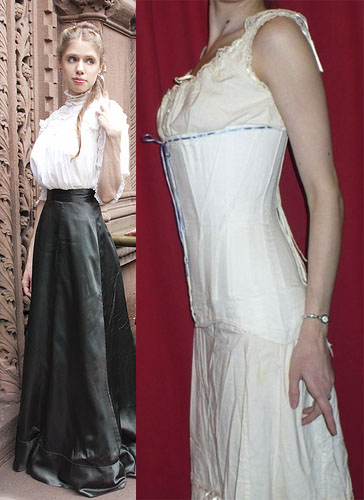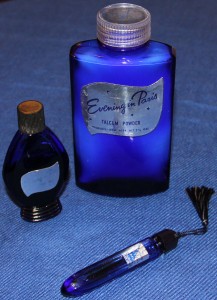Underbust Update
May 16th, 2011
I’m pleased to report some modest progress on my picnic ensemble, despite a busy weekend at work and a persistent headache. So far, I’ve been focused on building a viable under-structure for the bodice of my Empire frock. You’ll notice that I am now calling it Empire, as opposed to Regency, since the dress is taking on more and more of a French influence.
I have to admit I wasn’t too sure that this would work, even after making a quick version in muslin. But the linen under-bodice is really quite remarkable in the amount of support it offers — more than enough to dispense entirely with any thought of additional undergarments. It’s copied from the lining of Janet Arnold’s stomacher-front 1798-1805 morning dress, illustrated and diagrammed on pages 48 & 49 in Patterns of Fashion I.
I cheated and used the copier at work to enlarge the pattern. And, remarkably, had to make very few adjustments to make it fit like a glove: I added an inch to each side of the shoulder strap (I need to add length between the shoulder and bust points on most modern patterns as well) and it looks like I’ll be taking three inches out of the front of the bust (the original dress seems to have belonged to a very well-endowed lady).

Here is my version in progress, including pins marking the center front on my own modest bosom. The original lining in Arnold’s book was pinned closed(!) but I plan to make lacing eyelets as I don’t trust straight pins to hold firmly, or to refrain from stabbing me at an awkward moment. I’m also going to add a long cotton petticoat, possibly with a few tucks at the bottom, to make this a true bodiced-petticoat. The dress will be made separately since it needs to open at the back, while the bust support relies on front closure to achieve its desired effect.
In case you are curious, I’m sewing by hand, so far at least, and finishing by overcasting the seams and hemming the edges. A cursory search turned up no directions for assembling a frock from this period and I’ve never seen an extant example up close, so I am going with the directions from the Workwoman’s Guide, published about 30 years later. Because I was too lazy to go to the laundromat and wash something from my stash of linen, I cut out the bodice from an old linen tea cloth that I purchased at our museum’s stoop sale last Saturday. Lastly, I apologize in advance for the lack of a live-model in this and following “in-progress” pictures. I am not photographing this stage of fitting for obvious reasons.
Regency Indecency
May 12th, 2011
I am attending a neoclassical picnic later this month, and have decided to finally make that Regency-era dress I’ve been putting off for more than a decade. My mother bought me a copy of the Folkwear Empire Dress pattern, along with a length of sheer fabric printed with blue stripes and tiny blue flowers in the late 1990s. At the time, I was working for the George Read II House & Garden, an historic house build in the early 19th century, and had plans to sew an appropriate wardrobe.
So tonight, I grabbed some cheap muslin and cut out the Folkwear bodice. I’d already decided to use the skirt from Janet Arnold instead of making the gored skirt included in the pattern (I’ve never seen a gored Regency skirt…not that I know much about this period). Alas, after hastily stitching the bodice together and gathering it over my corset lace because I was too lazy to hunt for a proper drawstring, I discovered that I also hate the top of this dress. Please don’t misunderstand; it’s a lovely pattern and I adore Folkwear, but it just isn’t what I’m looking for this time.
Here’s what I’m trying to match:

Young Woman in White, circa 1798, oil on canvas,
attributed to the circle of Jacques-Louis David.
Well, perhaps not exactly. I’m not sure I’m brave enough to attend a picnic at a public garden with quite such a visible bust line. But I love the sleeves, the neck, the skirt, the hairdo, the shawl. I think I’ll add a straw hat too.
As for the pattern, I think Janet Arnold is going to be my best friend in this case. So I’m off to con my copy of Patterns of Fashion I. The big question that remains of course is whether she is wearing a bust-bodice or a bodiced petticoat (I am leaning towards the latter based on the volume of her skirts) and IS IT BONED??
P.S. I am saving the original blue striped and flowered material for an 1850s wrapper — it’s far too fussy to be properly Neoclassical — and I’ve pulled out a nice white-on-white striped sheer cotton that’s almost fine enough to be mull.
Famous Fragrance
February 19th, 2011
My parents visited last weekend, and brought a dainty treasure. This set of perfume, eau de toilette, and talcum powder belong to my grandmother. She’s kept them on her dressing table for nearly 80 years — since her beau (the one before my grandfather) gave them to her as a gift in the 1930s. Needless to say, I am honored to have been entrusted with their safe keeping now that Gram is beginning to sort through her things and pass them on.
The legendary fragrance Evening in Paris was launched in 1926 or 1928 by Bourjois (a leading name in French cosmetics since 1868). By the 1930s, the originally-pale-blue glass bottle had developed into what was to be its signature cobalt color. The curvy silver label is also typical of 1930s Evening in Paris products. Its popularity continued through the 1950s, when it was touted as “the most famous fragrance in the world.”
It went out of production in 1969, but Evening in Paris was revived in the late 20th century, and is now available from The Vermont Country Store. An online review claims that the new stuff doesn’t quite measure up to the original version however.
Back to my grandmother’s set: the perfume in the tiny bottle is long gone — either used or evaporated — but there is still a fair amount of eau de toilette remaining in the larger bottle. And there is plenty of delicately scented talc in the glass shaker as well. The fragrance is elegance personified. It’s rather powdery, as are most from this era (think Je Reviens by Worth), but the top notes are the lightest, sweetest, most exotic florals I’ve ever smelled. Chanel No. 5 is gauche by comparison. Sorry Coco.
Lacking a ruffled dressing table, not to mention the room to keep one (you will recall that I am a bohemian garret dweller), I will likely keep the precious bottles tucked away in a drawer. There they’ll be next to my own favorite bottle of scent — the one I wore as a maid (thank you Thomas Hardy for this delightfully quaint way of describing an unattached young woman), and last used on my wedding day. I know it’s a bit sentimental, but I like the idea of the perfume my grandmother used while she was being courted mingling its fumes with the one I wore during the same interlude in my own life…
And on that (top)note, I shall bid you good evening.
Teen Idol
January 24th, 2011
I don’t often talk about it, but I married a former teen idol.
His real name wasn’t commercial enough for fame and fortune in 1963, so they called him Billy Kidd. His first and only 45 rpm single record was made on the LarBell label — owned by the founders of The Four Preps — and features a very young Glen Campbell on guitar! Unlike many teen idols who only possessed a pretty face, mine was also a poet. He wrote both songs on the record:
Side A — “A Letter to Hayley”
“A Letter to Hayley” was later released by the aforementioned Four Preps (with some minor lyric changes) as “A Letter to the Beatles” and enjoyed a brief run on the pop charts before Brian Epstein got it pulled. In the early 2000’s, a Swedish concern released a compilation album of ‘forgotten’ teen idol tracks and included “A Letter to Hayley.”
Side B — “I Got Better Things to Do”
Less than a year after Billy Kidd made his debut, the Beatles landed in America and the world of popular music changed forever. By the Summer of Love (1967), the Kidd had transformed into a beautiful, bearded bard of the San Francisco folk-rock scene. Luckily for me, he was only passing through that world as well — on his way to a Greenwich Village garret, me, and whatever else is still waiting around the corner.
New Gores
January 19th, 2011
I discovered a few days ago that I’d made the stomach gores on my new stays too short by almost half. I first noticed the discrepancy while staring (for the 100th time) at the pattern illustration. Then, when I tried the half-finished pieces yet again on my own body, it occurred to me that all of the remaining fitting problems would likely be solved by beginning the stomach gores exactly at my waist, rather than over my hip bones.
Look at the difference in size between the old and new gores:

It’s perhaps telling that the only corsets I have made or worn with any success in the past have been in the Grecian Bend model. I used to volunteer at an Edwardian era house museum in northern Delaware (that’s a long story for another day) and so possessed a few appropriate outfits, plus the required undergarments.

The photo on the left was taken in Brooklyn, not so long ago. I was attending a Neo-Victorian Brunch in full-Edwardian attire with the marvelous Zoh. Photographer Anna Fischer snapped a picture of us standing on the stoop.
According to Wikipedia, the Grecian Bend (originally a dance step) goes back to the late 1860s, when fashionable women began to wear seriously projecting bustles, making them appear to lean forward and stick out their rears. It was also used to describe the posture of people with certain ailments as well as divers who came to the surface too quickly; in their case, the term was later shorted to “the bends.”
I have heard a song whose lyrics repeat “doing the Grecian Bend” on Radio Dismuke, but can’t seem to find the lyrics online. Not surprising, considering how rare most of Dismuke’s playlist is. You will just have to listen to his radio stream for a while and see if you come across it too.
Older Posts »

